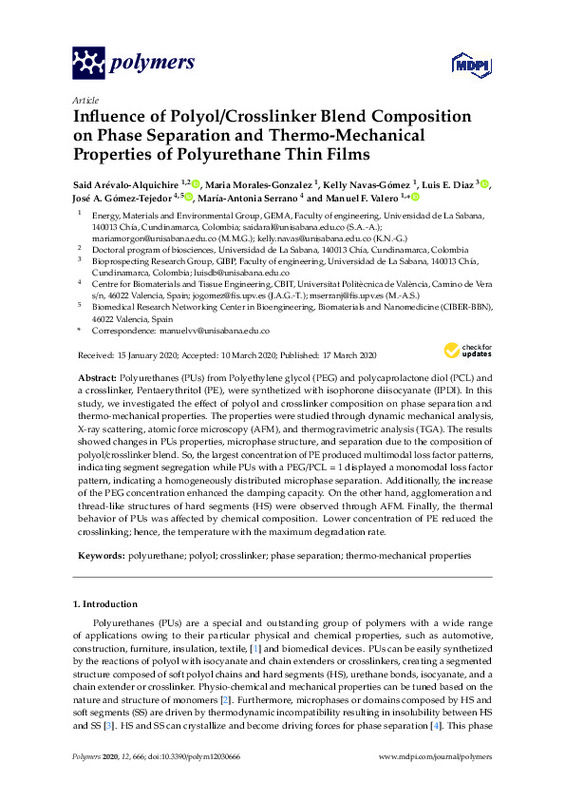Kim, H.-N., Lee, D.-W., Ryu, H., Song, G.-S., & Lee, D.-S. (2019). Preparation and Characterization of Isosorbide-Based Self-Healable Polyurethane Elastomers with Thermally Reversible Bonds. Molecules, 24(6), 1061. doi:10.3390/molecules24061061
Arévalo-Alquichire, S., Morales-Gonzalez, M., Diaz, L., & Valero, M. (2018). Surface Response Methodology-Based Mixture Design to Study the Influence of Polyol Blend Composition on Polyurethanes’ Properties. Molecules, 23(8), 1942. doi:10.3390/molecules23081942
Brzeska, J., Elert, A., Morawska, M., Sikorska, W., Kowalczuk, M., & Rutkowska, M. (2018). Branched Polyurethanes Based on Synthetic Polyhydroxybutyrate with Tunable Structure and Properties. Polymers, 10(8), 826. doi:10.3390/polym10080826
[+]
Kim, H.-N., Lee, D.-W., Ryu, H., Song, G.-S., & Lee, D.-S. (2019). Preparation and Characterization of Isosorbide-Based Self-Healable Polyurethane Elastomers with Thermally Reversible Bonds. Molecules, 24(6), 1061. doi:10.3390/molecules24061061
Arévalo-Alquichire, S., Morales-Gonzalez, M., Diaz, L., & Valero, M. (2018). Surface Response Methodology-Based Mixture Design to Study the Influence of Polyol Blend Composition on Polyurethanes’ Properties. Molecules, 23(8), 1942. doi:10.3390/molecules23081942
Brzeska, J., Elert, A., Morawska, M., Sikorska, W., Kowalczuk, M., & Rutkowska, M. (2018). Branched Polyurethanes Based on Synthetic Polyhydroxybutyrate with Tunable Structure and Properties. Polymers, 10(8), 826. doi:10.3390/polym10080826
Klinedinst, D. B., Yilgör, I., Yilgör, E., Zhang, M., & Wilkes, G. L. (2012). The effect of varying soft and hard segment length on the structure–property relationships of segmented polyurethanes based on a linear symmetric diisocyanate, 1,4-butanediol and PTMO soft segments. Polymer, 53(23), 5358-5366. doi:10.1016/j.polymer.2012.08.005
Guazzini, T., Bronco, S., Carignani, E., & Pizzanelli, S. (2019). Tunable ionization degree in cationic polyurethanes and effects on phase separation. European Polymer Journal, 114, 298-307. doi:10.1016/j.eurpolymj.2019.02.023
Ordon, K., Szlachta, M., Szatkowski, P., & Pielichowska, K. (2019). Examining the effect of starch and hydroxyapatite crosslinking on the thermal properties of polyurethane-based biomaterials. Thermochimica Acta, 682, 178414. doi:10.1016/j.tca.2019.178414
Mondal, S., & Martin, D. (2012). Hydrolytic degradation of segmented polyurethane copolymers for biomedical applications. Polymer Degradation and Stability, 97(8), 1553-1561. doi:10.1016/j.polymdegradstab.2012.04.008
Wang, C., Xie, J., Xiao, X., Chen, S., & Wang, Y. (2019). Development of Nontoxic Biodegradable Polyurethanes Based on Polyhydroxyalkanoate and L-lysine Diisocyanate with Improved Mechanical Properties as New Elastomers Scaffolds. Polymers, 11(12), 1927. doi:10.3390/polym11121927
Li, J.-W., Lee, H.-T., Tsai, H.-A., Suen, M.-C., & Chiu, C.-W. (2018). Synthesis and Properties of Novel Polyurethanes Containing Long-Segment Fluorinated Chain Extenders. Polymers, 10(11), 1292. doi:10.3390/polym10111292
Amrollahi, M., Sadeghi, G. M. M., & Kashcooli, Y. (2011). Investigation of novel polyurethane elastomeric networks based on polybutadiene-ol/polypropyleneoxide mixture and their structure–properties relationship. Materials & Design, 32(7), 3933-3941. doi:10.1016/j.matdes.2011.02.039
Tan, C., Tirri, T., & Wilen, C.-E. (2017). Investigation on the Influence of Chain Extenders on the Performance of One-Component Moisture-Curable Polyurethane Adhesives. Polymers, 9(12), 184. doi:10.3390/polym9050184
Imre, B., Gojzewski, H., Check, C., Chartoff, R., & Vancso, G. J. (2017). Properties and Phase Structure of Polycaprolactone-Based Segmented Polyurethanes with Varying Hard and Soft Segments: Effects of Processing Conditions. Macromolecular Chemistry and Physics, 219(2), 1700214. doi:10.1002/macp.201700214
Mondal, S., & Hu, J. L. (2006). Structural characterization and mass transfer properties of nonporous segmented polyurethane membrane: Influence of hydrophilic and carboxylic group. Journal of Membrane Science, 274(1-2), 219-226. doi:10.1016/j.memsci.2005.08.016
Coleman, M. M., Pehlert, G. J., & Painter, P. C. (1996). Functional Group Accessibility in Hydrogen Bonded Polymer Blends. Macromolecules, 29(21), 6820-6831. doi:10.1021/ma9604045
Lei, W., Zhou, X., Fang, C., Li, Y., Song, Y., Wang, C., & Huang, Z. (2019). New approach to recycle office waste paper: Reinforcement for polyurethane with nano cellulose crystals extracted from waste paper. Waste Management, 95, 59-69. doi:10.1016/j.wasman.2019.06.003
Lei, W., Fang, C., Zhou, X., Li, Y., & Pu, M. (2018). Polyurethane elastomer composites reinforced with waste natural cellulosic fibers from office paper in thermal properties. Carbohydrate Polymers, 197, 385-394. doi:10.1016/j.carbpol.2018.06.036
Ma, C., Chen, E., Sun, T., Shi, S., & Fang, Q. (2012). Preparation and characterization of tetrapod-shaped ZnO whisker filled polyurethane cross-linked epoxy/polyurethane damping composites. Journal of Reinforced Plastics and Composites, 31(22), 1564-1575. doi:10.1177/0731684412446856
HUDA, M., DRZAL, L., MOHANTY, A., & MISRA, M. (2006). Chopped glass and recycled newspaper as reinforcement fibers in injection molded poly(lactic acid) (PLA) composites: A comparative study. Composites Science and Technology, 66(11-12), 1813-1824. doi:10.1016/j.compscitech.2005.10.015
Li, T., Zheng, T., Han, J., Liu, Z., Guo, Z.-X., Zhuang, Z., … Guo, B.-H. (2019). Effects of Diisocyanate Structure and Disulfide Chain Extender on Hard Segmental Packing and Self-Healing Property of Polyurea Elastomers. Polymers, 11(5), 838. doi:10.3390/polym11050838
Cao, Q., & Liu, P. (2007). Crystalline-amorphous phase transition of hyperbranched polyurethane phase change materials for energy storage. Journal of Materials Science, 42(14), 5661-5665. doi:10.1007/s10853-006-0884-z
Pang, G. K. ., Baba-Kishi, K. ., & Patel, A. (2000). Topographic and phase-contrast imaging in atomic force microscopy. Ultramicroscopy, 81(2), 35-40. doi:10.1016/s0304-3991(99)00164-3
Lu, X., Xu, M., Sheng, Y., Li, Z., & Li, H. (2019). Preparation of polyurethanes with broad damping temperature range and self-healing properties. Journal of Elastomers & Plastics, 52(5), 410-431. doi:10.1177/0095244319863153
Schön, P., Bagdi, K., Molnár, K., Markus, P., Pukánszky, B., & Julius Vancso, G. (2011). Quantitative mapping of elastic moduli at the nanoscale in phase separated polyurethanes by AFM. European Polymer Journal, 47(4), 692-698. doi:10.1016/j.eurpolymj.2010.09.029
Sui, H. L., Liu, X. Y., Zhong, F. C., Li, X. Y., & Ju, X. (2013). A study of radiation effects on polyester urethane using two-dimensional correlation analysis based on thermogravimetric data. Polymer Degradation and Stability, 98(1), 255-260. doi:10.1016/j.polymdegradstab.2012.10.003
Parcheta, P., Głowińska, E., & Datta, J. (2020). Effect of bio-based components on the chemical structure, thermal stability and mechanical properties of green thermoplastic polyurethane elastomers. European Polymer Journal, 123, 109422. doi:10.1016/j.eurpolymj.2019.109422
[-]









